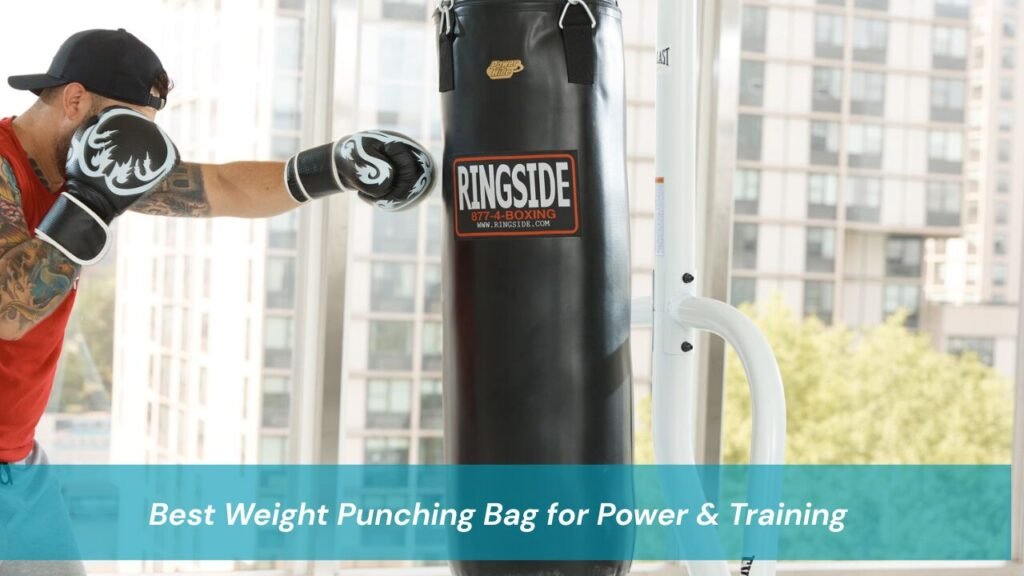Punching bags have been a cornerstone of combat sports and fitness training for decades. They are versatile tools that not only improve striking skills but also enhance endurance, coordination, and overall physical conditioning. For anyone serious about boxing, martial arts, or even high-intensity fitness routines, the punching bag is a must-have. Yet, one of the most important questions often overlooked is: what is the best weight punching bag for your training needs?
The weight of the bag you choose determines how it responds to strikes, how much resistance it provides, and ultimately how effective your workout will be. Selecting the wrong weight can lead to frustration, poor technique development, or even injuries. On the other hand, choosing the right bag can elevate your training, making it more efficient, enjoyable, and tailored to your goals.
In this guide, we will explore everything you need to know about finding the best weight punching bag, including the science behind bag weight, the different types of punching bags available, expert recommendations, and practical tips to make the right choice.
Why the Weight of a Punching Bag Matters
The weight of a punching bag directly affects how it behaves during training. A lighter bag, for instance, will swing more when struck, forcing the athlete to adjust footwork, timing, and accuracy. This type of training is excellent for developing speed and agility but may not be ideal for someone who wants to build power. On the opposite end of the spectrum, a heavier bag absorbs more force and moves less, making it perfect for practicing strength-based punches and combinations.
When a bag is too light for your body weight or strength level, you may find it unstable and difficult to control. It can swing excessively, interrupting rhythm and reducing the effectiveness of your strikes. Conversely, when the bag is too heavy, it can put excessive strain on the wrists and shoulders, especially for beginners who are still developing proper technique. A balance is therefore essential.
How to Match Bag Weight to Your Body
A common rule of thumb used by trainers and gyms is that the punching bag should weigh roughly half of your body weight. If you weigh 160 pounds, for example, a bag around 70 to 80 pounds will likely suit you well. This rule ensures that the bag provides enough resistance to simulate a real opponent while still allowing for some movement.
However, this guideline is not absolute. A lighter fighter who wants to focus on building raw punching power may choose a slightly heavier bag, while a heavier athlete who wants to emphasize speed and technique might go lighter. The key is to align the bag’s weight with both your body size and your training objectives.
Training Goals and Bag Weight
Your fitness and combat sports goals should play a major role in determining the ideal punching bag weight. If your primary goal is to develop raw strength and powerful punches, a heavier bag will give you the stability and resistance needed to push your limits. The reduced swinging motion allows you to dig into your punches and work on transferring body weight effectively into every strike.
For those who aim to improve speed, endurance, and cardiovascular conditioning, a medium-weight bag is usually a better choice. It moves enough to keep you on your toes, forcing you to combine offense with defensive footwork and head movement. This style of training is particularly beneficial for athletes preparing for sparring or competitive fights, as it mirrors the unpredictability of a live opponent.
If accuracy and timing are your focus, a lighter bag or a specialty bag, such as a double-end bag or speed bag, will be more effective. These bags move quickly when struck, challenging you to hit precise targets and maintain control of combinations.
Types of Punching Bags and Their Ideal Weights
The best weight punching bag for you also depends on the type of bag you intend to use. Traditional heavy bags are the most common, but there are several variations, each designed for specific training purposes.
A classic heavy bag, which hangs from the ceiling, is generally cylindrical and ranges from 70 to 150 pounds or more. It is the most versatile option and is suitable for boxers, kickboxers, and martial artists alike. For the average user, a 100-pound heavy bag is considered the gold standard, offering a balance between resistance and mobility.
Freestanding bags are another popular option, particularly for home gyms where hanging a bag from the ceiling is impractical. These bags sit on a weighted base that is usually filled with sand or water. While the overall structure is lighter, the base provides stability. The advantage of freestanding bags is portability, though they typically cannot match the durability and resistance of a heavy hanging bag.
For fighters looking to train low kicks, knees, and full-body strikes, Muay Thai or long bags are ideal. These are heavier and longer than standard heavy bags, often weighing over 120 pounds. The extra length allows athletes to practice strikes at different levels, making them essential for martial arts training.
Aqua bags, filled with water instead of traditional fiber or sand, are growing in popularity. They provide a more forgiving striking surface, reducing stress on joints and wrists. The weight of an aqua bag can be adjusted depending on how much water is added, typically ranging from 60 to 150 pounds.
Space, Setup, and Practical Considerations
Beyond weight, you also need to consider where you will install your punching bag. Hanging a 100-pound bag requires a strong ceiling joist or wall bracket, which may not be possible in all spaces. Improper installation can damage ceilings or walls and pose safety risks. Freestanding bags are easier to set up but may shift during intense training sessions.
The height of the bag is also important. Ideally, the bag should hang so that its center is at chest level. This allows you to practice a variety of punches comfortably, from uppercuts to body shots. For taller athletes or those practicing kicks, longer bags are recommended.
What Trainers and Experts Recommend
Professional trainers often recommend starting with a medium-weight bag unless you have specific power or endurance goals. According to boxing experts at FightCamp, the average heavy bag in a boxing gym weighs around 100 pounds because it works well for most users, regardless of skill level. For beginners, starting with a 70 to 80-pound bag allows for technical development without overwhelming the body. As skills improve, upgrading to a heavier bag provides a natural progression in training intensity.
Trainers also emphasize listening to your body. If your wrists, elbows, or shoulders feel strained, the bag may be too heavy, or your technique may need adjustment. Conversely, if you find yourself chasing the bag around the room after every punch, it is likely too light for your strength.
Real-World Example Gym Setups
Most commercial boxing gyms keep a range of heavy bags from 70 pounds to over 150 pounds. This allows athletes of different sizes and skill levels to select the bag best suited to their training session. For instance, a beginner weighing 140 pounds may start with an 80-pound bag to focus on form, while a professional heavyweight fighter may use a 150-pound bag to train knockout power.
At home, space limitations often dictate the choice. Many fitness enthusiasts opt for a 100-pound bag because it provides a balance of challenge and practicality. Freestanding bags, which usually fall between 70 and 120 pounds, are also common in residential setups.
Common Mistakes When Choosing Bag Weight
One of the biggest mistakes beginners make is selecting a bag that is too light. While a lighter bag may seem easier to work with, it can quickly become frustrating when it swings excessively and disrupts combinations. On the other hand, choosing a bag that is too heavy can discourage beginners by making training sessions feel punishing rather than productive.
Another common issue is neglecting long-term goals. Many people buy their first bag without considering how their training might evolve. A beginner who quickly progresses may outgrow a 60-pound bag in a matter of months, leading to the need for a replacement sooner than expected. Investing in a slightly heavier, more versatile bag can often be more cost-effective in the long run.
FAQs
What weight punching bag should a beginner use?
Beginners typically benefit from a bag weighing between 70 and 80 pounds. This range provides enough resistance to practice technique without overwhelming the joints and muscles.
Can a punching bag be too heavy?
Yes, if a bag is too heavy, it can limit movement, reduce the ability to practice footwork, and put unnecessary strain on the body. A balance between stability and mobility is essential.
Are freestanding bags as effective as heavy bags?
Freestanding bags are practical for limited spaces and casual training but are not as durable or stable as traditional heavy bags. They are better suited for fitness workouts rather than professional boxing training.
How can I tell if my ceiling can support a heavy bag?
If you plan to hang a heavy bag, consult a professional or ensure your ceiling joist is reinforced. Most ceilings can handle up to 100 pounds with proper hardware, but heavier bags may require specialized mounts or stands.
Do punching bags need to be maintained?
Yes, over time, bags can settle, lose shape, or develop weak spots. Rotating the bag regularly, checking the chains or straps, and refilling when necessary can extend its lifespan.
Conclusion
Choosing the best weight punching bag is not just about following a standard chart it’s about understanding your body, your goals, and your training environment. For most users, a 100-pound bag strikes the perfect balance, offering enough resistance for powerful strikes while still allowing mobility for endurance and speed work. Beginners can start lighter to focus on technique, while advanced fighters may move up to heavier bags to develop strength and durability.
Ultimately, the right punching bag is one that challenges you without causing unnecessary strain, fits comfortably in your space, and aligns with your long-term training goals. By investing in the correct weight and type of bag, you set yourself up for more effective workouts, steady progress, and greater enjoyment in every session.
Visit Boxing Essential to explore more.




